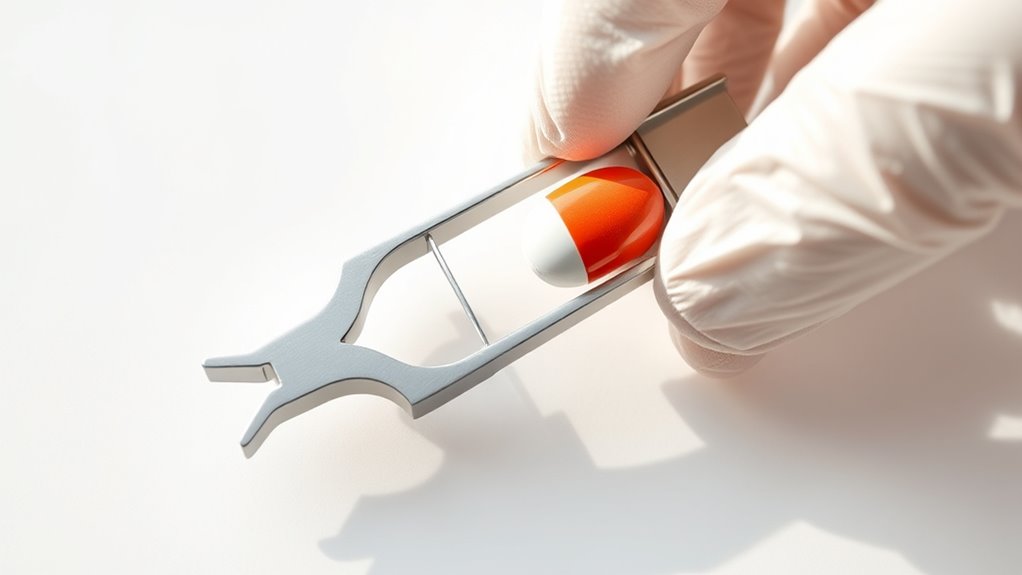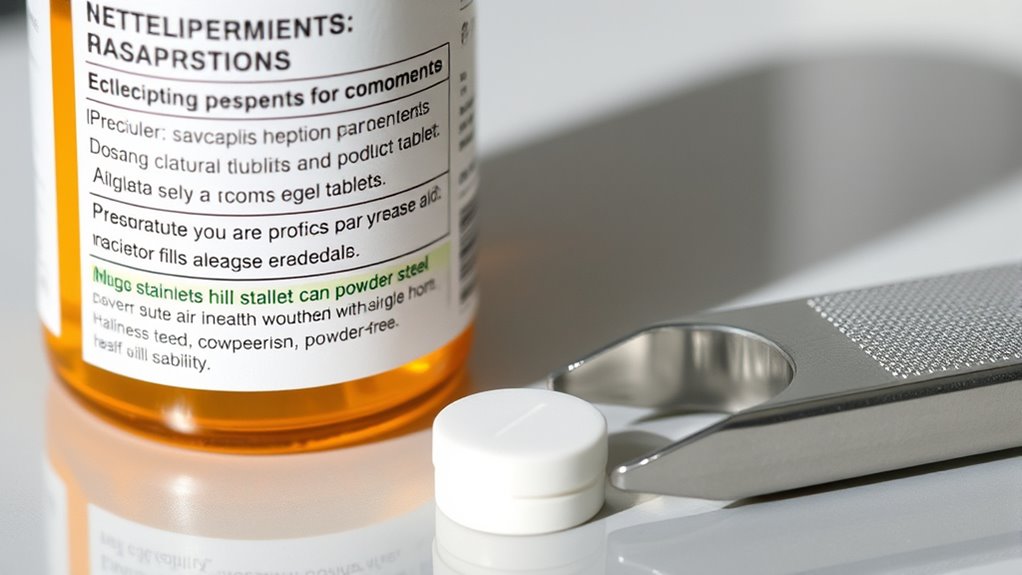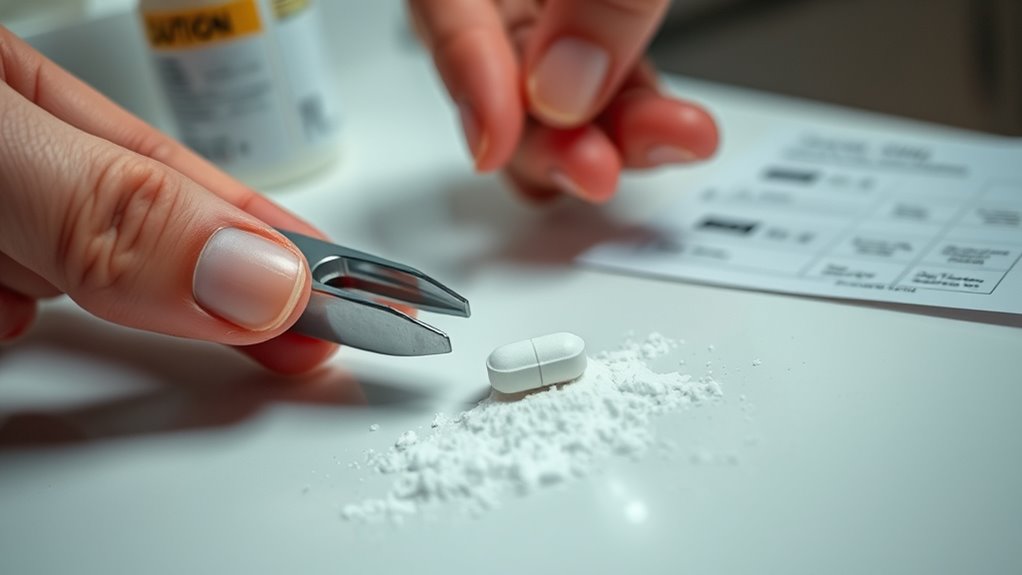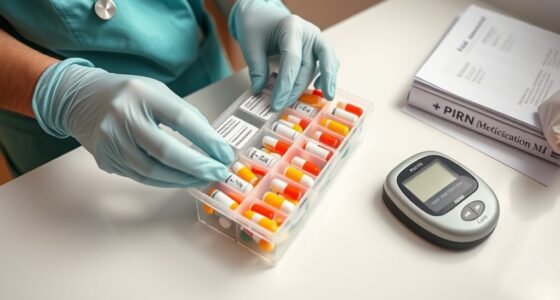Pill splitting can be safe when you follow proper guidelines, such as using a pill splitter, only splitting scored tablets, and checking with your healthcare provider. Avoid splitting extended-release, coated, or enteric-coated pills, as doing so can affect safety and effectiveness. Always verify instructions on the label and consult your pharmacist before splitting any medication. To learn more about safe practices and precautions, keep exploring this important topic.
Key Takeaways
- Splitting is safe for medications with a clear score line and no extended-release, enteric coating, or special design.
- Never split pills not intended for splitting, such as extended-release, sustained-release, or coated drugs.
- Always verify with a healthcare professional or pharmacist before splitting, especially to avoid altering efficacy or safety.
- Use proper tools like pill splitters or sharp knives and handle pills carefully to ensure accurate halves.
- Avoid splitting medications with complex formulations or high risks of dosage errors to prevent health complications.
Understanding Why People Split Pills

People often split pills to save money, because smaller doses can be cheaper or more affordable than buying larger quantities. When you split pills, you might also consider pill crushing to make swallowing easier or to tailor doses precisely. Proper medication storage becomes essential here; keeping leftover halves in labeled containers prevents mix-ups and maintains medication integrity. Splitting pills allows you to adjust doses to your specific needs, especially if your doctor advises a lower amount. However, it’s important to understand which pills are suitable for splitting—some may lose effectiveness or become unsafe if altered. Always store split pills carefully to avoid contamination or degradation. Additionally, utilizing crochet tools can help in creating labels or organizing medication containers for better management. This approach can be cost-effective, but it’s important to follow safe practices for medication storage and handling.
Medications Suitable for Splitting

Not all medications are safe to split, so it’s important to verify which types are appropriate. You should always look for clear labeling that indicates a pill can be divided. Understanding these guidelines helps ensure you split pills safely and effectively. Additionally, consulting with a healthcare professional can help confirm whether splitting a specific medication is advisable, especially considering potential risks or the presence of scam companies that might promote unsafe practices.
Appropriate Medication Types
Choosing medications suitable for splitting depends on their formulation and dosage stability. Not all pills are safe to split, especially if they contain layers or coatings that affect absorption. Medications that can be split typically have a score line, but you should still verify their suitability. Be cautious of pill crushing, which can alter how a drug works or increase the risk of drug interactions. Additionally, projector image quality plays a role in accurate medication dosing, as clear visual cues are essential for precise splitting. Consider these factors:
- The medication’s stability after splitting
- Whether it’s scored for even breaking
- Potential changes in drug absorption
- The risk of unintended drug interactions
Avoid splitting medications that aren’t designed for it, as this can lead to uneven doses or compromised effectiveness. Always check with your pharmacist if you’re unsure about splitting a specific medication.
Clear Labeling Importance
Why is clear labeling so essential when selecting medications for splitting? Because accurate labels guarantee you choose the right pill, especially when considering pill color and shape. Medications suitable for splitting typically have markings or labels indicating their safety and dosage. If the label is unclear or missing, you risk splitting the wrong pill or damaging the medication’s effectiveness. Pill shape matters too—some shapes are designed for splitting, while others are not. Clear labels help identify these features quickly, reducing errors. Proper labeling also confirms the medication’s purpose and instructions, preventing dangerous mistakes. Always verify that the pill’s color, shape, and labeling match the information provided by your healthcare provider before splitting. This ensures safety and maintains the medication’s integrity. Additionally, mindfulness techniques can help you stay attentive and focused when handling medications, reducing the chance of errors.
Medications That Should Never Be Split

Some medications should never be split because doing so can alter their effectiveness or safety. Certain pills are designed with specific coatings or extended-release features that can be compromised through pill crushing or splitting. Tablet design plays a pivotal role—if a medication isn’t meant to be divided, it may release its active ingredients too quickly or become less effective. Proper storage and organization can help ensure you follow medication instructions correctly and avoid accidental splitting. You should avoid splitting:
- Extended-release or sustained-release tablets
- Enteric-coated pills that protect your stomach
- Pills with special coatings for targeted delivery
- Medications with dangerous side effects if altered
Splitting these medications risks changing how they work or causing harm. Always check labels or consult your pharmacist before attempting to split any pill.
How to Properly Split Pills Safely

Splitting pills safely requires careful preparation and the right tools to guarantee accuracy and minimize risks. Use a pill splitter or a sharp, clean knife for precise cuts, avoiding pill crushing, which can affect dosage. Always handle split pills with clean hands and store the unused portion properly to prevent contamination. Keep medications in a secure, labeled container to avoid mix-ups. When splitting, place the pill on a stable surface, and press down evenly to prevent crumbling. Proper technique ensures accurate dosing and maintains medication integrity. Here’s a quick overview:
| Tool/Technique | Best Practice | Storage Tip |
|---|---|---|
| Pill splitter | Use a dedicated device for accuracy | Keep in original container |
| Handling | Handle with clean hands | Store away from children |
| Pill crushing | Avoid crushing unless necessary | Label storage clearly |
| Storage | Keep in a dry, secure place | Replace lids tightly |
Being aware of medication stability is important to ensure that splitting does not compromise the medication’s effectiveness.
The Role of Prescription Labels and Instructions

Prescription labels and instructions play a crucial role in making certain you take medications safely and effectively. They provide essential details that guide proper use, especially when pill splitting is involved. For example, the label may specify if a pill can be split, taking into account its pill shape or color. Key points to contemplate include:
Always follow prescription labels carefully to ensure safe, effective medication use and proper pill splitting.
- Confirming the pill’s shape, as some are scored for splitting, while others are not.
- Noting the pill color to distinguish between medications and avoid mistakes.
- Following specific instructions on whether splitting is recommended or safe.
- Paying attention to dosage details to prevent under- or overdosing.
Always adhere to these instructions and consult your pharmacist if anything is unclear. Proper understanding of labels ensures safe medication management and effective treatment.
Risks Associated With Improper Pill Splitting

Splitting pills improperly can lead to dosage inaccuracies that might reduce effectiveness or cause harm. You also risk medication stability issues if pills are not designed to be split, which can change how the drug works. Additionally, incorrect splitting may increase side effects or cause unexpected reactions, so it’s important to be cautious. Being aware of medication guidelines can help ensure safe and effective pill splitting practices.
Dosage Inaccuracy Risks
When pill splitting is done improperly, it can lead to significant dosage inaccuracies that potentially harm your health. You might end up taking too much or too little medication, which can reduce effectiveness or cause adverse effects. This is especially risky with pediatric considerations, where precise dosing is vital. For children, liquid medication options may be safer to avoid splitting errors. Be aware that:
- Uneven pill halves can cause uneven drug distribution
- Crushed or split pills may alter absorption rates
- Small miscalculations can lead to underdosing or overdosing
- Certain medications lose stability or potency if not split correctly
Always consult your healthcare provider before splitting pills, especially for children or critical medications, to guarantee safety and accuracy.
Medication Stability Concerns
Improper pill splitting can compromise the medication’s stability and potency, potentially reducing its effectiveness or causing harmful changes. When you crush pills to split them, especially if they aren’t designed for it, you risk altering the medication’s chemical composition. This can lead to uneven doses, making the drug less effective or causing unexpected side effects. Additionally, mishandling pills during splitting or crushing can affect medication storage, increasing exposure to moisture or air that degrades the drug. If your pills are sensitive, improper handling can accelerate deterioration. Always follow storage instructions and avoid crushing pills unless approved by your healthcare provider. Proper pill splitting techniques and understanding the medication’s stability are essential to ensure you get the intended therapeutic benefits safely.
Potential Side Effects
If you don’t follow proper techniques when splitting pills, you risk exposing yourself to a range of potential side effects. These can include unpredictable drug interactions that reduce effectiveness or cause adverse reactions. Improperly split pills may lead to dose inconsistencies, increasing the risk of overdose or underdose. You might also face allergy risks if you aren’t aware of how splitting affects ingredient release. Additionally, uneven splitting can cause irritation or damage to your mouth and digestive tract. Be cautious, especially with medications that have extended-release or coated formulations, as splitting them can alter their safety profile. Always consult your healthcare provider before splitting pills to avoid these potential side effects and ensure safe medication management.
Alternatives to Pill Splitting for Cost Savings

Are there better ways to save money on medications without splitting pills? Yes. Exploring cost saving strategies can improve medication affordability without risking safety. One effective approach is to ask your healthcare provider or pharmacist about generic alternatives, which often cost less than brand-name drugs. You can also inquire if there are lower-dose options available that meet your needs, reducing the need to split pills. Additionally, check if your insurance offers medication discounts or assistance programs. Buying in bulk or through mail-order pharmacies can also lower costs. These strategies help you save money while ensuring you take medications safely and effectively. Remember, avoiding pill splitting when unnecessary minimizes risks and supports better health outcomes.
Consulting Healthcare Professionals Before Splitting

Before you consider splitting pills, it’s important to consult with healthcare professionals such as your doctor or pharmacist. They can advise you on whether splitting is safe for your specific medication and health situation. For example, if you have medication allergies, splitting certain pills might increase the risk of adverse reactions. Also, some medications are not suitable for pill crushing or splitting because it can alter their effectiveness or cause uneven dosing. Additionally, understanding the best laundry detergents can ensure that your laundry remains safe and effective, especially when using medications that require careful storage or handling. Consider asking your healthcare provider:
Always consult your healthcare provider before splitting pills to ensure safety and proper medication use.
- Is splitting this medication safe for me?
- Are there alternative forms, like liquids or patches?
- Could splitting affect the medication’s efficacy?
- Are there risks related to my medication allergies?
Always seek professional guidance to avoid unintended health complications.
Recognizing When to Avoid Splitting Your Medication

Knowing when to avoid splitting your medication is crucial for ensuring its safety and effectiveness. If the pill is coated, enteric-coated, or extended-release, splitting can compromise its design, potentially causing uneven dosing or faster drug release. Avoid pill crushing unless specifically instructed by your healthcare provider, as some medications lose potency or become unsafe when crushed. Be cautious if you have difficulty with medication storage; splitting uneven pills can lead to incorrect doses and make storage more complicated. Also, if your medication has uneven shapes or textures, splitting may result in inconsistent doses. Recognizing proper medication handling helps prevent medication errors and preserves the medication’s intended benefits. Always consult your healthcare professional before splitting or crushing pills to guarantee safety.
Frequently Asked Questions
Can Pill Splitting Impact Medication Effectiveness?
Splitting pills can impact medication effectiveness by altering medication potency and absorption rates. If you don’t split pills accurately, you might reduce their strength or change how quickly the drug is absorbed in your body. This can lead to suboptimal treatment or side effects. Always check with your healthcare provider before splitting pills to guarantee it’s safe, especially for medications where precise dosing is critical for effectiveness.
Are There Specific Tools Recommended for Splitting Pills Accurately?
Imagine holding a tiny, precise tool in your hand, ready to split a pill perfectly in half. For accurate splitting, you should use a pill cutter or pill splitter, which are specifically designed for this purpose. These tools help guarantee even doses, reducing errors. Always choose a sturdy, sharp pill splitter for best results, and follow instructions carefully to keep your medication effective and safe.
How Does Splitting Pills Affect Insurance or Pharmacy Records?
When you split pills, it can impact your insurance implications and pharmacy record accuracy. Your pharmacy records might show a different medication quantity or type, which could affect insurance claims or coverage. Always inform your pharmacist if you plan to split pills, so they can update your records accordingly. This guarantees your insurance benefits stay accurate and your medication history remains correct, preventing potential issues with claims or future prescriptions.
What Are the Legal Considerations When Splitting Prescribed Medication?
You might wonder if splitting your medication is legal. The answer hinges on legal compliance and prescription regulations. If your doctor or pharmacist approves, it’s generally safe—yet unauthorized splitting can breach laws or void insurance coverage. Always check your prescription details and consult healthcare professionals. Ignoring these rules could lead to legal issues or compromised health. Stay informed and follow proper procedures to avoid unnecessary risks or legal complications.
Can Splitting Pills Cause Unintended Side Effects?
Splitting pills can sometimes cause unintended side effects if it alters your pill dosage or affects medication stability. If the medication isn’t designed to be split, you might get an uneven dose or reduce its effectiveness, leading to potential side effects. Always check with your healthcare provider before splitting pills, as they can advise whether it’s safe and help ensure you uphold proper medication stability.
Conclusion
Remember, pill splitting is like walking a tightrope—you need balance and careful steps. Always follow your healthcare provider’s guidance and read labels thoroughly. When in doubt, don’t take the risk of splitting medications that could harm you. It’s better to be cautious than to stumble into avoidable dangers. Your health is your treasure, so handle it with care and seek professional advice to keep your journey safe and steady.









